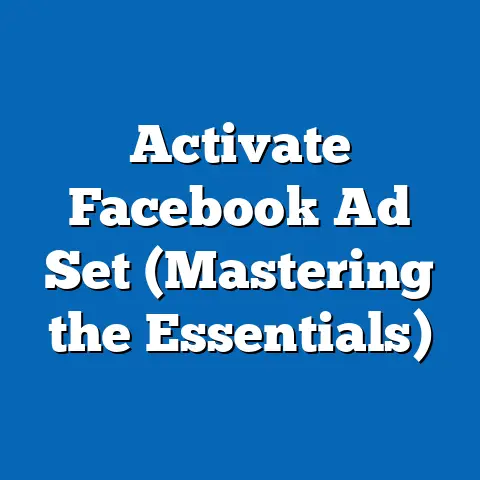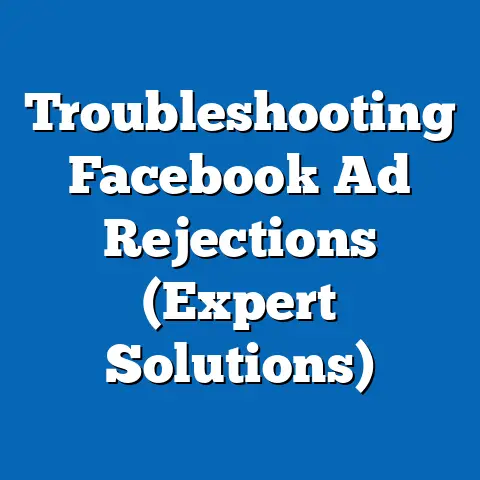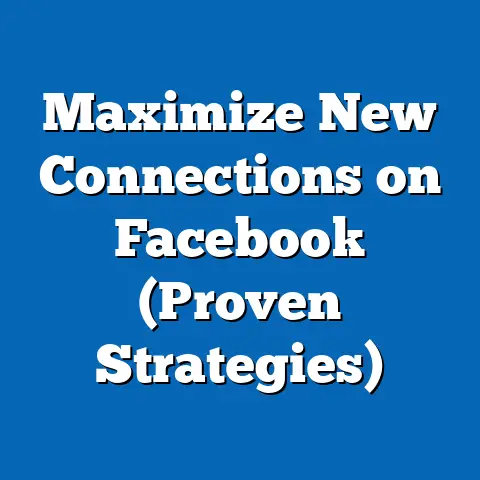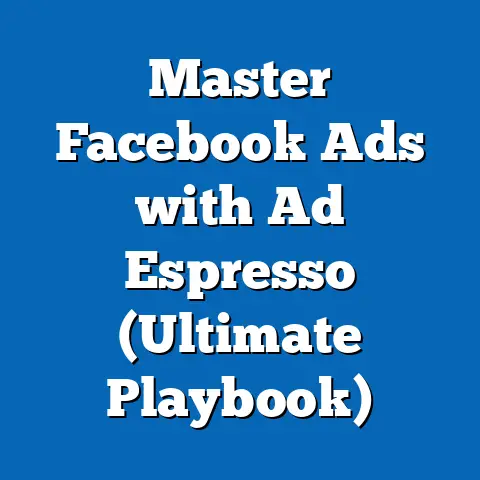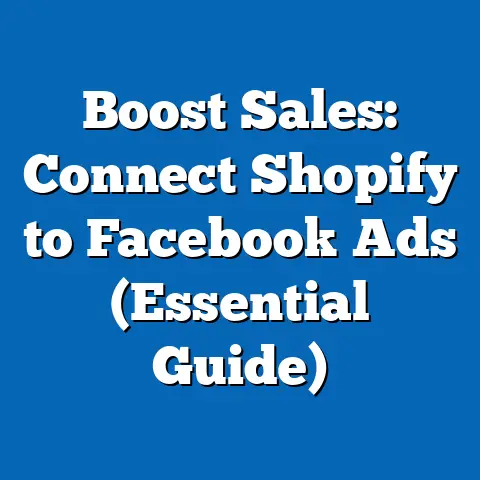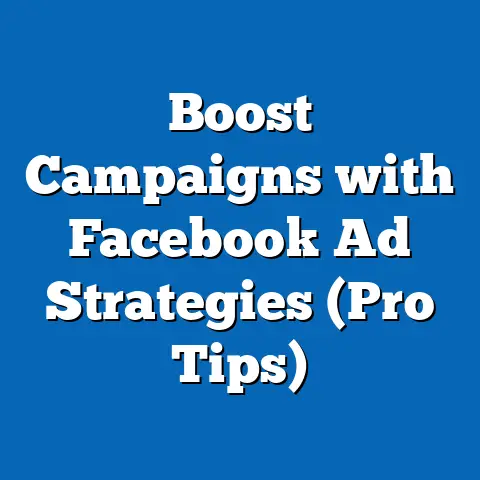Unpacking Facebook’s Ad Surge (Strategic Insights Revealed)
The digital marketing landscape is a constantly shifting terrain. What works today might be obsolete tomorrow. This is especially true when it comes to Facebook advertising. Algorithms change, user behaviors evolve, and market conditions fluctuate, demanding continuous adjustments from businesses that want to stay relevant and effective. I’ve seen firsthand how companies that cling to outdated strategies get left behind, while those that embrace change and experiment thrive.
Over the past few years, we’ve witnessed a significant “ad surge” on Facebook. This isn’t just about an increase in the sheer volume of ads; it’s about a sophisticated evolution in how those ads are delivered, targeted, and optimized. Understanding the strategic elements behind this surge is vital for any business looking to succeed in this competitive arena. In this article, I’ll take you on a deep dive into the underlying strategies, data, and insights that have contributed to Facebook’s advertising success. We’ll explore the evolution of the platform, analyze the factors driving the surge, uncover strategic insights for advertisers, examine successful case studies, and even peer into the future of Facebook advertising. Let’s get started!
Section 1: The Evolution of Facebook Advertising
To truly understand the current state of Facebook advertising, it’s essential to understand its journey. I remember the early days when Facebook ads were simple sidebar banners – a far cry from the sophisticated campaigns we see today.
A Brief History
Facebook’s advertising history can be traced back to 2004, shortly after the platform’s launch. Initially, ads were primarily focused on promoting other websites and services. However, as Facebook’s user base grew exponentially, so did its advertising potential.
- Early Years (2004-2007): Basic banner ads and simple targeting options. The focus was more on driving traffic than conversions.
- The Introduction of Facebook Pages (2007): This allowed businesses to create a presence on the platform and interact with users directly. It marked a shift from purely external advertising to building a community within Facebook.
- The Rise of Social Ads (2009): Facebook introduced social ads that leveraged user connections and recommendations. Seeing that a friend “liked” a product added a powerful layer of social proof.
- Mobile Advertising (2012): With the explosion of smartphone usage, Facebook prioritized mobile advertising, optimizing ad formats and targeting options for mobile devices. This was a game-changer, as it allowed businesses to reach users on the go.
- The Acquisition of Instagram (2012): This opened up new advertising opportunities on a visually driven platform, expanding Facebook’s reach and demographic targeting capabilities.
- Advanced Targeting (2013-Present): Facebook continued to refine its targeting capabilities, introducing custom audiences, lookalike audiences, and detailed demographic and interest-based targeting. I’ve personally seen incredible results using lookalike audiences based on my best customers.
- Video Advertising (2014-Present): The rise of video content led to the introduction of video ads, which quickly became one of the most engaging and effective ad formats.
- Focus on Automation and AI (2017-Present): Facebook has increasingly focused on automation and AI-driven optimization, allowing advertisers to leverage machine learning to improve ad performance. Campaign Budget Optimization (CBO) and Advantage+ campaign budget are prime examples.
Key Innovations
Facebook’s success in advertising is largely due to its continuous innovation and willingness to adapt to changing market trends. I’ve always admired their ability to identify emerging opportunities and integrate them into their advertising platform.
- Video Ads: The introduction of video ads revolutionized Facebook advertising. Video ads are far more engaging than static images and allow businesses to tell compelling stories and showcase their products in action. I’ve found that short, attention-grabbing videos perform exceptionally well.
- Carousel Ads: Carousel ads allow advertisers to showcase multiple products or features within a single ad unit. This is particularly effective for e-commerce businesses looking to highlight their product catalog. I’ve used carousel ads to showcase different angles of a product or highlight key features, leading to a significant increase in click-through rates.
- Collection Ads: Similar to carousel ads, collection ads are designed for mobile e-commerce. They feature a main video or image with related products displayed below, creating a seamless shopping experience within Facebook.
- Lead Ads: Lead ads make it easy for users to submit their information without leaving the Facebook platform. This is particularly effective for generating leads for services or high-value products. I’ve used lead ads to collect email addresses for my newsletter and seen a much higher conversion rate compared to traditional landing pages.
- Dynamic Ads: Dynamic ads automatically show the most relevant products to users based on their browsing history and interests. This is a powerful tool for retargeting and driving sales. I’ve used dynamic ads to retarget users who viewed specific products on my website, resulting in a significant increase in conversion rates.
- Instant Experiences (formerly Canvas Ads): Instant Experiences are full-screen, mobile-optimized ads that load instantly within Facebook. They provide a rich and immersive experience for users, allowing them to explore products, watch videos, and interact with content without leaving the platform.
Data-Driven Decisions
Facebook’s advertising platform is built on data. The platform collects a vast amount of information about its users, including their demographics, interests, behaviors, and connections. This data is then used to refine targeting options and optimize ad performance.
- User Behavior Tracking: Facebook tracks user behavior on and off the platform, including website visits, app usage, and purchase history. This data is used to create detailed user profiles and target ads based on specific interests and behaviors.
- Engagement Metrics: Facebook provides advertisers with a wealth of engagement metrics, including likes, comments, shares, clicks, and video views. These metrics allow advertisers to track ad performance and optimize their campaigns for better results. I pay close attention to click-through rates (CTR) and cost-per-click (CPC) to identify underperforming ads and make necessary adjustments.
- A/B Testing: Facebook allows advertisers to A/B test different ad creatives, targeting options, and placements to identify what works best. This is a crucial step in optimizing ad performance and maximizing ROI. I always recommend testing different headlines, images, and calls-to-action to see what resonates most with your audience.
- Audience Insights: Facebook provides advertisers with audience insights that offer valuable information about their target audience, including their demographics, interests, behaviors, and top pages. This information can be used to refine targeting options and create more relevant and engaging ads.
Takeaway: Understanding the evolution of Facebook advertising, the key innovations that have shaped the platform, and the importance of data-driven decisions is crucial for success. By leveraging the platform’s advanced targeting capabilities and optimizing ad performance based on engagement metrics, advertisers can achieve significant results.
Section 2: Understanding the Surge
The “ad surge” on Facebook is not just a coincidence. It’s the result of a confluence of factors that have transformed the platform into one of the most powerful advertising channels in the world.
Current Statistics
The numbers speak for themselves. Facebook’s advertising revenue has consistently grown over the years, solidifying its position as a dominant player in the digital advertising market.
- Revenue Growth: In 2023, Meta (Facebook’s parent company) reported advertising revenue of \$134.9 billion, representing a significant increase compared to previous years. This demonstrates the continued growth and importance of Facebook advertising.
- Daily Active Users (DAUs): As of Q4 2023, Facebook had 2.06 billion daily active users on average, demonstrating its massive reach and potential for advertisers.
- Monthly Active Users (MAUs): Facebook’s monthly active users reached 3.07 billion as of Q4 2023, further highlighting its global presence and advertising opportunities.
- Mobile Advertising Dominance: Mobile advertising accounts for a significant portion of Facebook’s total advertising revenue, reflecting the shift towards mobile-first marketing strategies.
- Ad Impressions: Facebook delivers billions of ad impressions every day, providing advertisers with ample opportunities to reach their target audience.
(Note: These numbers are approximate and based on publicly available data. Refer to Meta’s official reports for the most up-to-date information.)
Factors Driving the Surge
Several factors have contributed to the surge in Facebook ads, including increased user time on the platform, the rise of mobile advertising, enhanced targeting capabilities, and the impact of economic conditions.
- Increased User Time on the Platform: People are spending more time on Facebook than ever before. This increased engagement translates into more opportunities for advertisers to reach their target audience. I’ve noticed that users are particularly active in Facebook groups and communities, making them a valuable channel for targeted advertising.
- The Rise of Mobile Advertising: With the proliferation of smartphones, mobile advertising has become increasingly important. Facebook has successfully adapted to this trend, optimizing its ad formats and targeting options for mobile devices. I’ve found that mobile-optimized ads tend to perform better than desktop ads, especially for driving app installs and local business promotions.
- Enhanced Targeting Capabilities and Audience Segmentation: Facebook’s advanced targeting capabilities allow advertisers to reach specific demographics, interests, and behaviors. This level of granularity ensures that ads are shown to the most relevant audience, increasing the likelihood of engagement and conversion. I’ve used custom audiences and lookalike audiences to target users who are most likely to be interested in my products or services.
- The Impact of Economic Conditions on Advertising Budgets: During periods of economic growth, businesses tend to increase their advertising budgets to capitalize on increased consumer spending. Conversely, during economic downturns, businesses may shift their advertising spend towards more cost-effective channels like Facebook.
Comparative Analysis
While other social media platforms also offer advertising opportunities, Facebook stands out due to its massive reach, advanced targeting capabilities, and diverse ad formats.
- Reach: Facebook has a significantly larger user base than most other social media platforms, providing advertisers with a wider audience to target.
- Targeting: Facebook’s targeting capabilities are unmatched by other platforms. Advertisers can target users based on a wide range of demographics, interests, behaviors, and connections.
- Ad Formats: Facebook offers a diverse range of ad formats, including image ads, video ads, carousel ads, collection ads, and lead ads. This variety allows advertisers to choose the most effective ad format for their specific goals.
- Cost-Effectiveness: Facebook advertising can be more cost-effective than other advertising channels, especially for reaching a large audience with targeted ads. I’ve found that Facebook ads often provide a better ROI compared to traditional advertising methods like print or television.
Takeaway: The surge in Facebook ads is driven by a combination of factors, including increased user engagement, the rise of mobile advertising, enhanced targeting capabilities, and economic conditions. Facebook’s massive reach, advanced targeting options, and diverse ad formats make it a powerful advertising channel for businesses of all sizes.
Section 3: Strategic Insights for Advertisers
To make the most of Facebook’s advertising potential, it’s essential to understand and implement effective strategies. I’ve spent years experimenting with different approaches and have identified several key insights that can help advertisers achieve better results.
Targeting Strategies
Targeting the right audience is crucial for the success of any Facebook ad campaign. Facebook offers a variety of targeting options, including demographic targeting, interest-based targeting, behavioral targeting, custom audiences, and lookalike audiences.
- Demographic Targeting: This allows advertisers to target users based on their age, gender, location, education, and other demographic factors. This is a good starting point for broad targeting.
- Interest-Based Targeting: This allows advertisers to target users based on their interests, hobbies, and passions. This is particularly effective for reaching users who are interested in specific products or services.
- Behavioral Targeting: This allows advertisers to target users based on their online behavior, such as website visits, app usage, and purchase history. This is a powerful tool for retargeting and driving sales.
- Custom Audiences: Custom audiences allow advertisers to upload their own customer data (e.g., email addresses, phone numbers) and target those users on Facebook. This is a great way to reach existing customers and build brand loyalty. I’ve used custom audiences to target users who have purchased from my website in the past, offering them exclusive discounts and promotions.
- Lookalike Audiences: Lookalike audiences allow advertisers to create new audiences that are similar to their existing customers or website visitors. This is a powerful tool for expanding reach and finding new customers. I’ve found that lookalike audiences based on my best customers tend to perform exceptionally well.
Creative Best Practices
Creating compelling and engaging ad creatives is essential for capturing users’ attention and driving results. Here are some best practices to keep in mind:
- Visuals: Use high-quality images or videos that are visually appealing and relevant to your target audience. I’ve found that visually striking images tend to perform better than generic stock photos.
- Messaging: Craft clear and concise ad copy that highlights the benefits of your product or service. Use persuasive language and a strong call-to-action. I always recommend testing different headlines and ad copy variations to see what resonates most with your audience.
- Call-to-Action (CTA): Include a clear and compelling call-to-action that tells users what you want them to do (e.g., “Shop Now,” “Learn More,” “Sign Up”). Make sure your CTA is prominent and easy to click.
- Relevance: Ensure that your ad creative is relevant to your target audience and the context in which it is being displayed. Irrelevant ads are likely to be ignored or even marked as spam.
- Mobile Optimization: Optimize your ad creatives for mobile devices. Use a mobile-friendly layout, large fonts, and clear calls-to-action that are easy to tap on a touchscreen.
Ad Placement Optimization
Facebook offers a variety of ad placements, including news feed ads, right column ads, instant articles, in-stream video ads, and audience network ads. Each placement has its own unique characteristics and advantages.
- News Feed Ads: These ads appear directly in users’ news feeds and are typically the most engaging and effective ad format.
- Right Column Ads: These ads appear in the right column of the Facebook website and are typically less engaging than news feed ads.
- Instant Articles: These ads appear within Facebook’s instant articles, providing a seamless reading experience for users.
- In-Stream Video Ads: These ads appear within video content on Facebook and are a great way to reach users who are watching videos.
- Audience Network Ads: These ads appear on websites and apps outside of Facebook, allowing advertisers to expand their reach beyond the Facebook platform.
To optimize ad placement, it’s important to test different placements and track their performance. I typically start by running ads in the news feed and then experiment with other placements to see what works best for my specific goals.
Takeaway: Strategic targeting, compelling ad creatives, and optimized ad placement are essential for success on Facebook. By leveraging the platform’s advanced targeting capabilities, creating visually appealing ads, and testing different placements, advertisers can maximize their ROI and achieve their marketing goals.
Section 4: Case Studies of Successful Campaigns
To illustrate the power of effective Facebook advertising, let’s examine a few case studies from diverse industries. These examples will highlight the tactics employed and the results achieved, providing valuable lessons for other advertisers.
Case Study 1: E-commerce (Fashion Retail)
- Company: A women’s fashion retailer looking to increase online sales.
- Challenge: Reaching a wider audience and driving conversions in a competitive market.
- Strategy:
- Targeting: Used lookalike audiences based on their existing customer base, targeting women aged 25-45 with interests in fashion, style, and online shopping.
- Creative: Created visually appealing carousel ads showcasing their latest clothing collections, with each carousel card featuring a different product and a clear “Shop Now” button.
- Placement: Primarily focused on news feed ads on both desktop and mobile devices.
- Retargeting: Implemented dynamic ads to retarget users who had viewed products on their website but hadn’t made a purchase.
- Results:
- Increased online sales by 40%.
- Improved click-through rate by 25%.
- Reduced cost-per-acquisition by 15%.
- Key Lesson: Using lookalike audiences and visually appealing carousel ads can effectively drive sales for e-commerce businesses. Retargeting users who have shown interest in your products can significantly increase conversion rates.
- Targeting: Used lookalike audiences based on their existing customer base, targeting women aged 25-45 with interests in fashion, style, and online shopping.
- Creative: Created visually appealing carousel ads showcasing their latest clothing collections, with each carousel card featuring a different product and a clear “Shop Now” button.
- Placement: Primarily focused on news feed ads on both desktop and mobile devices.
- Retargeting: Implemented dynamic ads to retarget users who had viewed products on their website but hadn’t made a purchase.
- Increased online sales by 40%.
- Improved click-through rate by 25%.
- Reduced cost-per-acquisition by 15%.
Case Study 2: Technology (Software Company)
- Company: A software company offering a project management tool.
- Challenge: Generating qualified leads for their sales team.
- Strategy:
- Targeting: Targeted professionals in project management, IT, and software development roles, using interest-based targeting and LinkedIn data.
- Creative: Created lead ads offering a free trial of their software, highlighting the key benefits and features.
- Placement: Primarily focused on news feed ads on LinkedIn and Facebook.
- Follow-up: Implemented an automated email sequence to nurture leads and encourage them to sign up for a paid subscription.
- Results:
- Generated 500 qualified leads in one month.
- Increased conversion rate from leads to paid subscribers by 10%.
- Reduced cost-per-lead by 20%.
- Key Lesson: Lead ads are an effective way to generate qualified leads for B2B businesses. Offering a free trial or valuable content can incentivize users to submit their information.
- Targeting: Targeted professionals in project management, IT, and software development roles, using interest-based targeting and LinkedIn data.
- Creative: Created lead ads offering a free trial of their software, highlighting the key benefits and features.
- Placement: Primarily focused on news feed ads on LinkedIn and Facebook.
- Follow-up: Implemented an automated email sequence to nurture leads and encourage them to sign up for a paid subscription.
- Generated 500 qualified leads in one month.
- Increased conversion rate from leads to paid subscribers by 10%.
- Reduced cost-per-lead by 20%.
Case Study 3: Local Business (Restaurant)
- Company: A local restaurant looking to increase foot traffic.
- Challenge: Attracting new customers and promoting special offers.
- Strategy:
- Targeting: Targeted users within a 5-mile radius of the restaurant, using location-based targeting and interest-based targeting (e.g., foodies, dining enthusiasts).
- Creative: Created visually appealing image ads showcasing their most popular dishes, with a clear “Get Directions” button.
- Placement: Primarily focused on news feed ads on mobile devices.
- Special Offers: Promoted special offers and discounts to incentivize users to visit the restaurant.
- Results:
- Increased foot traffic by 30%.
- Improved brand awareness in the local community.
- Increased social media engagement.
- Key Lesson: Location-based targeting and visually appealing image ads can effectively drive foot traffic for local businesses. Promoting special offers and discounts can incentivize users to visit your establishment.
- Targeting: Targeted users within a 5-mile radius of the restaurant, using location-based targeting and interest-based targeting (e.g., foodies, dining enthusiasts).
- Creative: Created visually appealing image ads showcasing their most popular dishes, with a clear “Get Directions” button.
- Placement: Primarily focused on news feed ads on mobile devices.
- Special Offers: Promoted special offers and discounts to incentivize users to visit the restaurant.
- Increased foot traffic by 30%.
- Improved brand awareness in the local community.
- Increased social media engagement.
Takeaway: These case studies demonstrate the power of effective Facebook advertising across diverse industries. By understanding your target audience, creating compelling ad creatives, and optimizing ad placement, you can achieve significant results and drive your business goals.
Section 5: The Future of Facebook Advertising
The world of Facebook advertising is constantly evolving, with new trends and technologies emerging all the time. To stay ahead of the curve, it’s important to understand the future of Facebook advertising and how it may impact your business.
Emerging Trends
Several emerging trends are shaping the future of Facebook advertising, including the integration of augmented reality (AR), AI-driven personalization, and the impact of privacy regulations.
- Augmented Reality (AR): AR is poised to revolutionize Facebook advertising, allowing users to interact with products in a more immersive and engaging way. For example, users could virtually “try on” clothing or “place” furniture in their homes before making a purchase.
- AI-Driven Personalization: AI is already playing a significant role in Facebook advertising, and its influence is only set to grow in the future. AI can be used to personalize ad creatives, targeting options, and bidding strategies, resulting in more effective and efficient campaigns. I’ve seen firsthand how AI-powered tools can optimize ad spend and improve ROI.
- Privacy Regulations: As privacy regulations become more stringent, Facebook will need to adapt its advertising practices to comply with these regulations. This may involve reducing the amount of data collected about users and providing users with more control over their privacy settings.
Predictions
Based on current trends and emerging technologies, here are some predictions for how Facebook advertising may evolve over the next few years:
- Increased Focus on Video: Video will continue to be the dominant ad format on Facebook, with more emphasis on short-form, mobile-optimized videos.
- Greater Personalization: AI will enable more personalized ad experiences, with ads tailored to individual users’ interests and behaviors.
- Integration of E-commerce: Facebook will continue to integrate e-commerce features into its platform, making it easier for users to shop directly from ads.
- Emphasis on Privacy: Facebook will prioritize user privacy and provide users with more control over their data.
- Rise of AR and VR: Augmented reality and virtual reality will play a more prominent role in Facebook advertising, creating immersive and engaging ad experiences.
Challenges Ahead
Despite its continued success, Facebook faces several challenges in maintaining its ad dominance, including competition from other platforms and regulatory scrutiny.
- Competition from Other Platforms: Facebook faces increasing competition from other social media platforms, such as TikTok and Instagram, which are attracting younger audiences and ad dollars.
- Regulatory Scrutiny: Facebook is under increasing regulatory scrutiny regarding its data privacy practices and its impact on society. This scrutiny could lead to new regulations that limit Facebook’s ability to collect and use user data for advertising purposes.
- Changing User Preferences: User preferences are constantly evolving, and Facebook needs to adapt to these changes to remain relevant. If Facebook fails to keep up with changing user preferences, it could lose users and ad revenue to other platforms.
Takeaway: The future of Facebook advertising is dynamic and uncertain. By understanding emerging trends, making informed predictions, and addressing potential challenges, businesses can prepare for the future and continue to thrive in the ever-changing landscape of Facebook advertising.
Conclusion
Facebook’s ad surge is a testament to its adaptability, innovation, and data-driven approach. From its humble beginnings as a simple banner ad platform to its current status as a global advertising powerhouse, Facebook has continuously evolved to meet the changing needs of advertisers and users alike.
As we’ve explored in this article, the strategic elements behind Facebook’s ad surge are multifaceted. They include:
- Understanding the evolution of the platform: Knowing where Facebook advertising came from helps us appreciate where it’s going.
- Analyzing the factors driving the surge: Understanding the underlying drivers of growth allows us to capitalize on emerging opportunities.
- Uncovering strategic insights for advertisers: Implementing effective targeting strategies, creating compelling ad creatives, and optimizing ad placement are crucial for success.
- Examining successful case studies: Learning from the successes of others can provide valuable inspiration and guidance.
- Peering into the future of Facebook advertising: Anticipating emerging trends and preparing for potential challenges can help us stay ahead of the curve.
In the ever-changing world of digital marketing, adaptability is key. Businesses that can embrace change, experiment with new strategies, and leverage data to optimize their campaigns will be best positioned to thrive in the Facebook advertising ecosystem. By understanding the strategic elements behind Facebook’s ad surge, you can unlock the platform’s full potential and achieve your marketing goals.
So, take these insights, experiment with your campaigns, and continue to learn and adapt. The future of Facebook advertising is bright, and with the right strategies, you can be a part of it. Good luck!

